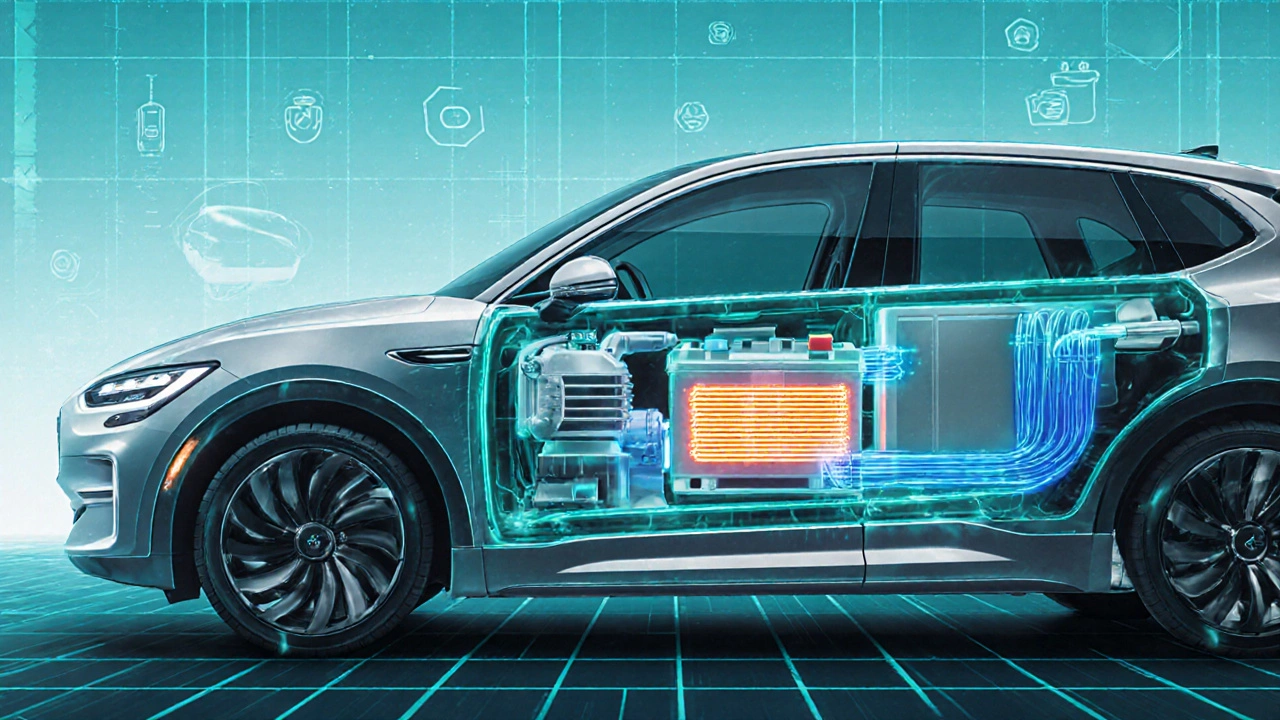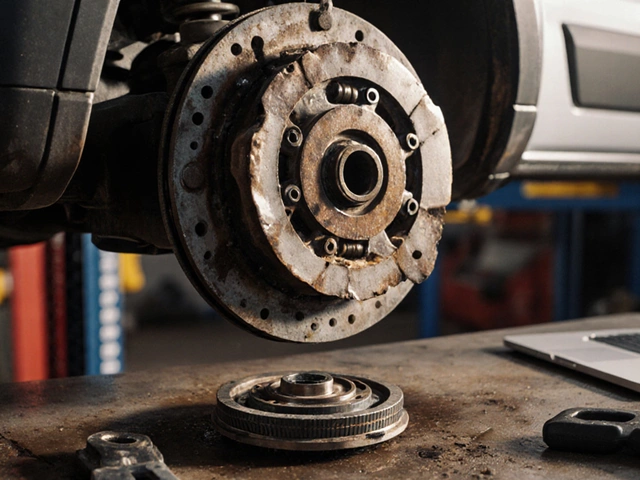
Cooling System Efficiency Calculator
Calculate Your Cooling System Impact
Key Takeaways
- Traditional liquid‑cooled car radiators are still common, but many new models replace them with electric‑driven cooling solutions.
- Electric vehicles (EVs) use heat pumps, refrigerant‑based exchangers, and electric fans that are more efficient at low‑speed operation.
- Hybrid powertrains keep a small radiator for the combustion engine, but the overall system size shrinks dramatically.
- Maintainers need to learn new diagnostic tools for coolant‑less systems, but the basic principle - moving heat away from the powertrain - stays the same.
- When buying a car, check the cooling architecture: radiator, heat pump, or a combination, to understand service costs and parts availability.
The Traditional Role of a Car Radiator
Car radiator is a heat exchanger that transfers heat from hot engine coolant to ambient air, keeping the engine within its optimal temperature range. When a gasoline or diesel engine runs, combustion raises the metal temperature far above safe limits. Coolant circulates through the engine block, picks up heat, and then flows through the radiator where fins and a fan dissipate that heat into the airflow.
Because the radiator sits at the front of the vehicle, it receives natural airflow while you drive. The design dates back to the early 1900s, when simple copper‑and‑tin plates were replaced by aluminum cores with thin tubes for better heat transfer. In most cars built before 2015, the radiator remains the primary cooling component.
How Modern Engines Changed the Cooling Game
Two trends pushed radiator design toward its limits. First, higher specific output - turbocharging, direct injection, and variable valve timing - cranked engine temperatures up by 20‑30 °C compared with naturally aspirated engines of the 1990s. Second, stricter emissions standards forced manufacturers to run engines leaner, which also raises combustion temperatures.
To cope, engineers added larger fans, electronic thermostats, and even secondary coolers for oil and transmission fluid. The radiator got bigger, heavier, and more complex. In some premium models, you’ll find a dual‑pass core or a separate intercooler that pre‑cools the charge air, but all of these still rely on the same basic principle: a liquid‑to‑air heat exchanger.

Rise of Electric Vehicles and New Cooling Tech
Electric vehicle cooling is a suite of systems that manage temperature for battery packs, power electronics, and sometimes the motor, using refrigerant cycles, electric pumps, and heat pumps rather than a large liquid‑to‑air radiator. An EV has no combustion engine, so the classic radiator loses its purpose. Instead, two cooling challenges arise:
- Battery temperature control: Lithium‑ion cells perform best between 20 °C and 35 °C. Too cold and power drops; too hot and longevity suffers.
- Power electronics cooling: Inverters and DC‑DC converters generate significant heat, especially under hard acceleration.
Manufacturers solve these problems with compact, electrically‑driven pumps, high‑efficiency fans, and most recently, heat pumps is devices that move heat from a colder area to a warmer one using refrigerant, similar to an air‑conditioner but reversible for heating. A heat pump can warm the cabin in winter using waste heat from the battery, then switch to cooling mode in summer, all while keeping the battery in its sweet spot.
Heat Pumps vs Traditional Radiators
| Aspect | Traditional Radiator (Combustion Engine) | EV Heat‑Pump System |
|---|---|---|
| Primary Coolant | Water‑glycol mixture | Refrigerant (R‑134a or R‑1234yf) + optional liquid coolant for battery |
| Power Source for Pump/Fan | Engine‑driven mechanical pump, electric fan | Fully electric pump and fan, powered by high‑voltage battery |
| Heat Transfer Medium | Air flowing over aluminum fins | Refrigerant cycle with compressor, condenser, evaporator |
| Vehicle Types | Gasoline, diesel, hybrids (combustion side) | Pure electric cars, plug‑in hybrids (electric side) |
| Efficiency at Low Speed | Reduced - relies on fan, can waste energy | High - electric pump runs at optimal speed, heat pump recovers waste heat |
| Complexity | Mechanical pump, thermostat, fan clutch | Compressor, expansion valve, multiple sensors, software control |
| Typical Maintenance | Coolant flush every 2‑3 years, fan bearing checks | Refrigerant leak checks, software diagnostics, occasional pump replacement |

Common Misconceptions About ‘No Radiator’ Cars
When you hear “no radiator,” it’s easy to picture a car that simply runs hotter. The truth is more nuanced:
- My car still has a small radiator. Hybrid models keep a miniature radiator for the internal combustion engine, but it’s far smaller because the engine runs intermittently.
- Heat pumps replace the radiator entirely. They replace the bulk of the liquid‑to‑air exchanger for the powertrain, but a tiny coolant loop may still exist for the motor bearings.
- Electric fans are less reliable. Modern electric fans are controlled by multiple temperature sensors and can operate at variable speeds, offering better cooling at low speeds than a fixed‑speed mechanical fan.
In short, modern cars still move heat - they just do it with different hardware.
What This Means for Car Owners and DIY Mechanics
If you’re used to pulling a radiator, checking for leaks, and topping up coolant, you’ll need to adapt a few habits:
- Learn the location of the thermostat is a valve that opens or closes to regulate coolant flow based on engine temperature sensor and the electronic control module (ECM) for EVs. Many diagnostics now happen via OBD‑II software rather than visual inspection.
- Keep an eye on the coolant is the fluid that absorbs heat from the engine or battery and transfers it to the cooling device level in EVs. Some models use a sealed refrigerant loop that you never refill; instead, you monitor pressure warnings.
- When a fan fails, the fault code will appear on the dashboard, and you’ll replace an electric motor rather than a fan clutch.
- Service intervals for heat‑pump‑based systems are typically longer-often 5‑8 years-because there are fewer moving parts that wear out.
For a DIY enthusiast, the biggest shift is moving from a hands‑on coolant flush to a software‑driven diagnostic session. Many garages now have a laptop with manufacturer‑specific scan tools that can command the pump, read refrigerant pressure, and even initiate a heat‑pump self‑test.
Frequently Asked Questions
Do modern cars still have radiators?
Yes. Most gasoline and diesel cars still use traditional radiators. Hybrids keep a small one for the combustion engine, while pure electric cars often replace it with a heat‑pump or refrigerant‑based cooling loop.
Why are electric cars moving away from radiators?
Electric powertrains generate heat differently and operate efficiently at lower temperatures. A heat‑pump can recover waste heat for cabin heating, improving overall energy efficiency, whereas a big radiator would add weight and drag without a combustion engine to cool.
Can I still replace the coolant in an EV?
Most EVs use a sealed refrigerant system, so there’s no regular coolant top‑up. Some models have a secondary liquid loop for the motor or battery that can be flushed, but this is usually handled by a dealer.
Is a heat‑pump more reliable than a radiator?
Heat‑pump systems have fewer moving parts (no large fan clutch, no mechanical pump), so they tend to be very reliable. Failure modes usually involve the electronic compressor or refrigerant leaks, both of which are rare and often covered under warranty.
Will maintenance costs go up with the new cooling tech?
Not necessarily. While you may need specialized diagnostic tools, the actual hardware-electric pumps, fans, and heat‑pump components-has long service intervals. Over the life of the vehicle, costs are often lower than maintaining a large radiator, coolant, and fan clutch.



